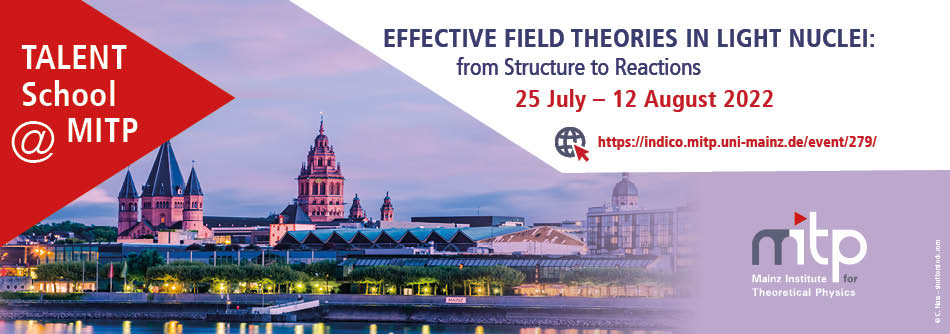This three-week summer school corresponds to the new version of the TALENT Course 3: "Few-body methods and nuclear reactions" with a particular emphasis on Effective field theories (EFTs). EFTs provide a powerful framework to exploit a separation of scales in physical systems. They are widely used in many branches of physics ranging from condensed matter to nuclear and particle physics. The goal of this new TALENT summer school is to provide the attendees with a high level training on EFTs for nuclear physics and on the numerical methods to solve the few-body problem for light nuclei in both structure and reaction theory.
The school will include the following lectures:
-
"Introduction to Effective Field Theory" by Hans-Wener Hammer (TU Darmstadt)
-
"Chiral Effective Field Theory and Nuclear Forces" by Kai Hebeler (TU Darmstadt)
-
"Few-Nucleon Structure" by Nir Barnea (Hebrew Univ. of Jerusalem)
-
"Few-Nucleon Reactions" by Sonia Bacca (JGU Mainz)
-
"Halo Effective Field Theory" by Daniel Phillips (Ohio University)
-
"Reactions with Halo Nuclei" by Pierre Capel (JGU Mainz)
The lectures will be held in the mornings, using blackboard and slides supported by Python notebooks to instigate the active learning of the students. As is customary in TALENT schools, the afternoons will be used for exercises and hands-on sessions, during which the students will apply the notions seen earlier to practical cases. These will include the use of existing computer programs and the development of codes by the students themselves.
With this school, we aim for the following learning outcomes:
-
Understand the notion of effective field theories and their application to a variety of problems in nuclear physics and beyond.
-
Learn how chiral-EFT interactions are built and used in practice.
-
Make contact with the numerical techniques and computer programs used by experts in solving few-nucleon problems.
-
Be able to solve numerically the two-body Schrödinger equation for bound and scattering states.
-
From those results, be able to construct observables and compare to experimental data.
-
Learn the different models of reaction that exist on the market and how to run some of the publicly available codes.
-
Use these competences to build a two-body Hamiltonian in Halo-EFT and include it within a working nuclear-reaction codes to analyse existing reaction data, e.g., for elastic scattering, transfer or breakup.
During the school social activities will be offered to the participants, as it is usually done at MITP summer schools. A keynote lecture and a tour of the Mainz Laboratory
at the Institut für Kernphysik are also programmed.

